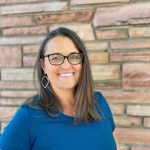Rebecca Shelton
Whitesburg, Kentucky
This interview was conducted by Carly Schmidt on December 7, 2022. Learn more about Rebecca’s work at https://aclc.org/.
Transcript
What is your role at the Appalachian Citizens’ Law Center (ACLC)?
I’ve been at the organization for 3.5 years and interned with them even before that. ACLC has a lot of different priorities, but our interest in water affordability has been a growing program area and was my entry point to River Network and the advocacy toolkit. ACLC was founded 20 years ago, and we are based in the heart of the coal fields in Central Appalachia. We were founded to address the harms of extractive industry and to hold the industry accountable for those harms. This typically looks like work around miner safety and health issues as well as work on land impacts, which includes water and public infrastructure.
How did these priorities lead you to the team at River Network?
ACLC was originally a public interest law firm and determined over the years that there’s a lot you can do as lawyers in terms of changing outcomes for individuals, but the legal tilt also gives insight into policy structures and structural changes that are needed. I say all that because our work in water affordability started with representing a citizen group, the Martin County Concerned Citizens, in Eastern Kentucky, on affordability issues. It’s a really challenging situation in which the water system needs $40-50 million to restore infrastructure. Folks still don’t drink the water that comes to their homes, yet they’re still paying for it. There’s a lot of investment needed, but it’s also unaffordable to people in the county, so we started exploring available funds in order to make these repairs. Hence my entry point into trying to understand state revolving funds (SRFs), how the process rolls out, and wanting to learn more from folks working in the SRF space.
We’re also trying to pass the STREAM Act, which would free up some of the funds from the Bipartisan Infrastructure Bill to address long-term treatment of acid mine drainage. Though separate from the SRFs, acid mine drainage affects our source water in this region and thus is also related to drinking water systems.
UPDATE on Feb 19, 2025: ACLC was successful in passing the STREAM Act!
Would you say that the citizen group approaching ACLC was the catalyst for your wanting to learn more about SRFs?
Our environmental justice attorney gets involved in a lot of different projects, but we got involved in Martin County because there was an active citizen group and there was a question at the time about what is causing the cost of water to soar. Martin County has experienced a lot of mining that impacted their source water, which was also affected by a terrible slurry spill in 2000. Originally, we thought there could be a direct connection to mining impacts, and it was a “yes, and…” situation. Yes, there were problems with treatment and infrastructure, but this ballooned into learning more about the challenges of this system. Affordability has really become a huge focus for us. We work primarily in rural areas with small water utility systems where there are declining population trends and lower income populations. All these factors combined emphasize the importance that all utility bills, not just water, are affordable.
You faced some significant barriers when you were initially trying to learn about SRFs in your state. What were some of these challenges?
My primary frustration was that there isn’t an institutional history of outreach and inclusion around these intended use plans. There aren’t good systems in place for people or organizations when they do want to learn more about these plans. I had signed up for listservs and notifications that I thought would be useful for staying up to date with drafts and the division’s process. I had reached out directly to ask about timelines and did not get a lot back. Ultimately, I only found out that the intended use plans had been published for comment because I randomly checked the website one day. At that point, I had 2 weeks to comment, which was difficult to navigate without the ability to plan for it and notify partners who wanted to be included as well. I’m hopeful that the opportunity we had to give comments and engagement with the plan will clear a path for future conversations around public engagement, but we’ll see! There is much to do when it comes to the public understanding this opportunity and what it means, and how the process works. And the process is not super straightforward, but I’m hopeful we can work together to get over that hump.
And flatten the learning curve, too!
The really important thing there is sufficient notice. That is such a barrier for engagement. Typically, the intended use plans are supposed to be drafted and open for comments in the spring, and that wasn’t the case and there were no notices about an adjusted timeline. They had a webinar, but I didn’t learn about it until a few days before. Public engagement doesn’t work if it’s inaccessible and part of accessibility is notice and transparent timelines so folks can build it into their schedules.
How will the SRF Toolkit help others trying to navigate this complicated process?
We were advising as much as we were learning through the process of developing the toolkit. I have dug into the history and wonkiness of different policies related to our work, around mine land reclamation and black lung, but I had not taken the time to dive into the SRFs history and policy. Being able to read the toolkit and understand how the folks who have been really embedded in this policy are thinking about it was really helpful. When it comes to advocacy tools too, I had never considered reaching out to EPA regional representatives. The Toolkit goes through this unique structure of advocacy that I was just not familiar with. Now it’s clear to me what the next steps are in the formal and institutional channels if we don’t see the progress we hope for within the state-level notice and comment process.
This process has also left me wondering what other programs or solutions are out there that would target funds to disadvantaged communities. It will take time for these funds to have an impact, so I’m thinking through complimentary solutions that would provide more short-term solutions around affordability. Extending the LIHWAP funds, for example, and getting more funding appropriated for that program. Those funds were rolled out in Kentucky and there was a real need for them, and now they’re gone. And through my work in the advocacy toolkit, it became apparent to me who is working in this space federally, while also helping me understand the intricacies of particular policies. [The Toolkit] will be an important reference point because it just aggregates everything.
What is your hope for SRF implementation in Kentucky and the communities you work in?
The flooding that happened in Kentucky this summer just emphasizes that our water systems are not at all resilient to these kinds of events. Some systems need to be completely rebuilt and most others need major repairs, and I don’t know where that funding is going to come from. I would love to see the SRFs be targeted toward those systems that really need to be rebuilt. The flooding has revealed so many challenges that the SRF program is designed to address. We need to build water systems that are more resilient in a way that is also affordable.
About
Rebecca Shelton joined ACLC’s staff in July 2019 after serving as a summer research intern in the summer of 2018. At ACLC she analyzes policy and co-convenes federal campaigns related to issues of mine land reclamation, mine worker safety and health, and drinking water to promote a more just and equitable future in Central Appalachia. She has a PhD in Sustainability Science from Arizona State University. Her dissertation was focused on understanding the politics of justice in energy transitions. Rebecca also has a M.S. in plant and soil science from the University of Kentucky College of Agriculture, Food, and the Environment and a B.S. in Earth and Environmental Science from Furman University.







